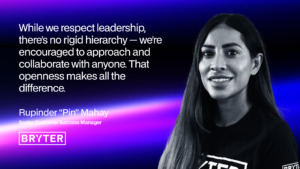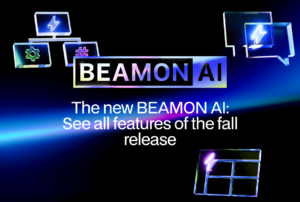Being a remote-first company, we value and recognize the importance of human relationships by creating trustful and meaningful connections with each other, regardless of where we are based, or what our role is in the organization, or the background we are coming from.
Aiming at creating the culture of belonging, we are explicit in formulating that BRYTER is a safe space to experiment, create and lead, no matter your core role. Leadership at BRYTER can be done by anybody. It takes into account the human aspect of all interactions, as well as the differences, that make the ongoing improvement proposals a part of the transparent company culture, valuing different points of view, and experiences so that any change can be reviewed and shaped by anyone in the organisation.
We hope that these snippets show how we align and work based on feedback, and at the organizational scale, and how we empower everybody to make decisions including these diverse points of view. So far, we’ve seen these practices help the company grow, enrich, and thrive while evolving at a very fast pace.
The BRYTER way of working
Our handbook is a compilation of principles, practices, and competencies that enable you to navigate through the BRYTER universe. It holds our knowledge on organizational and cultural aspects.
How we cultivate trustful relationships
Why we do it
We believe that having trustful relationships with each other is the single most important ingredient for achieving our vision. Workplace happiness and healthiness result in high performance. Replacing hierarchy with human relationships allow us to become a resilient network organization.
How we do it
We constantly seek to create an organization that engages the full potential of individuals from diverse backgrounds, where innovation can thrive because the views, beliefs and values of everyone are welcome. We always listen to each other. Listening drives innovation.
Some of the practices we use at BRYTER
These are some of the practices that help us cultivate trustful human relationships.

Check-In
With Check-In’s, we cultivate trustful relationships by taking time to share something personal at the beginning of a meeting. This helps us arrive in that space as human beings. By listening to each other with intention, we create an atmosphere of trust that will create the space needed for us to solve any work-related problems together.

Virtual get-togethers
We like to nurture our relationships and encourage our colleagues to join our daily virtual coffee at 9:30 CET each morning. This is an informal meeting where you can come together to talk about your pets, plans, hobbies, and just about anything but work. We also organise virtual lunches that give you the opportunity to cook and have lunch with a peer. It’s a great way to meet and talk to colleagues with whom you might not always work closely.

Caring Circles
A Caring Circle is a ‘Personal Board of Trustees’ you can set up that facilitates self-directed problem-solving by providing a safe, supportive space for reflection and growth. This Circle can help you (and other group members) process a feeling or tension into an actionable proposal or solution.

Welcome 1:1’s
When first joining BRYTER we ask you to schedule Get-to-know 1:1 sessions with 10 different folks on the team. These sessions are great opportunities to learn about what they do – in and outside of BRYTER – and to start building trustful relationships.

Onboarding buddies
All new joiners can rely on the support of a group of Onboarding Buddies that will provide context and guidance throughout your first days and weeks at BRYTER and answer all sorts of questions. Next to the Happiness Buddy who will welcome you on your first day and introduce you to our culture, there usually is a tech or unit buddy who will onboard you technically and a product buddy to provide further context around our product and mission.

Cultural Onboarding by the Founders
One of the duties of our founders is to enable you to bring your full potential, intelligence and wisdom into the workplace. In a series of 8 sessions, our founders guide you, together with your new-hire peers, in understanding how you can take ownership and be your own leader in order to make decisions fast within the BRYTER culture. It is also about building trustful relationships with the founders, just as you would with any other co-worker — since the power they hold often makes it a bit more difficult to connect, these sessions facilitate personal connection on the same eye level.

Use of non-gendered language
At BRYTER, we value the importance of not discriminating against one another and therefore remain inclusive of all of our colleagues. You are at ease with using generic conventions to refer to one another and are considerate to your peers.
Behaviors we desire
🎂 You laugh, joke and celebrate success – no matter if it is a big company milestone, your first day at work or your birthday or whatever makes you feel like celebrating.
🕺 You demand a lot from others, you also trust others and always assume best intentions.
💬 You openly communicate your thoughts, feelings and concerns and contribute to an environment that allows this.
🥴 You don’t discriminate against others based on color, origin, gender or sexual orientation. Instead, you value and include diversity as it is the main driver for innovation.
How we communicate this to new joiners
In this video, Michael Hübl, our CPO gives our new joiners an introduction to how we cultivate trustful relationships. This is a sneak peek into one of several Cultural Onboarding sessions given by the founders to enable you to arrive in the BRYTER workspace.
How we structure
Why we do it
We believe we need a responsive & scalable structure to grow continuously and out compete everyone in a volatile, uncertain, complex, and ambiguous world.
How we do it
We are remote-first and hire the best talent globally. We organize in cross-functional teams which work end-to-end to serve the needs of our customers.
We believe in the positive impact of cross-functional collaboration. We leverage this by working together in a network structure where information flows fluidly based on trustful, human relationships grounded in competence (and not a hierarchy of authority).
Practices we use
These principles and practices help us to be responsive & scalable.
Network structure
We are organized as a network of teams with a direct line of sight to the customer. We align regularly in our company gatherings making our objectives and strategies transparent to everyone and by this invite collaboration.
Independent teams
Teams – we call them units – are self-organized, cross-functional, independent and work end-to-end. With this, we have the ability to react quickly to change and scale fast as an organization.
Communities
Communities become the stable backbone of the organization. They support their members to work better in teams and help them to grow personally and professionally. We have various communities, i.e. for leadership, technology, product and more.
Remote work
We measure work by impact, not by time or location. BRYTER colleagues work together from 20+ different countries. We have established many practices that allow us to feel close with each other whilst working remotely.
Behaviors we desire
😎 You are also the smartest-working person in the room, as you measure success in the outcome, not the output. What counts is value created, not time invested.
👨🏽🎨 You are honest and always transparent, i.e. what you currently work on, why you made a decision, etc.
💬 You openly communicate your thoughts, feelings and concerns and contribute to an environment that allows this.
👩👩👧👦 You contribute to internal and external communities through blogging, publishing, public speaking, knowledge sharing and open-source contributions.
How we make decisions
Why we do it
First: We trust you. Second: To scale fast and efficiently, we need everyone to constantly make iterative improvements on personal & work-related needs, challenges, and opportunities (instead of depending on managers’ approvals). Therefore, we empower everyone to make decisions.
How we do it
We act on existing tensions, not on opinions, and foster a culture of collective wisdom and continuous learning. Tensions are a perceived gap between the current reality and the desired future. They can be needs, problems or opportunities and are a great signal for improvement proposals.
We are biased towards action and change. You take care that your improvement proposals are “safe enough to try” and “good enough for now“. We “default to yes” and accept them, unless a valid objection is raised during peer feedback.
The authority to make a change derives from tension. Everyone in the organization is obliged to improve continuously.
Practices we use
These practices empower everyone to make decisions.

Default to yes
We trust each other and therefore every one of your proposals is by default accepted. We give you the power up to decide if a proposal is “safe enough to try” and “good enough for now.” You make this decision after talking to your peers, experts and any affected co-workers. There is no one you need to ask for approval.

Proposal Thinking
We shifted the way we think about conflicts from “complaints” to proposals. Whenever you see an improvement need, you can “just do it”. Come up with a proposal and follow through.

Reaction Rounds
When you want to involve various perspectives, Reaction Rounds are a great way to discover new thoughts and insights. Just state your issue, tension, or proposal and let a group of peers reacts to it one by one. By doing this, you activate collective wisdom. This practice is quick and easy, as we are so used to sharing our thoughts freely, open and direct as we know that they are welcome.

Advice Process
To make the “best possible decision,” it is a good practice to talk to experts and affected co-workers and ask for their advice. Gathering multiple perspectives is the best way to solve complex problems.

Personal Tension Processing
Tensions are a perceived gap between the current reality and the desired future. Following up on tension and creating a proposal in response will improve not only your work, but also the work of your team and the whole organization. Therefore, we all have the obligation to sense and follow our tensions.
Behaviors we desire
💪You are powerful and empower others.
👨🏽🎨 You are honest and always transparent, i.e. what you currently work on, why you made a decision, etc.
🏋️♀️ You push yourself and your team to improve continuously. You strive for feedback, you admit failure and learn from it.
🚀You are cutting edge and go beyond.
How we do leadership
Why we do it
We believe that authority should be derived from competence, engagement and knowledge, not from the hierarchy. Success comes from collaboration and dedication. We believe everyone we hire is capable of providing leadership and taking ownership and continuously improving the organization.
How we do it
We empower everyone to lead and take ownership on a personal, team and organizational level. Everyone is responsible for making local improvements, processing and communicating needs, reaching out for feedback, and proactively working on objectives.
We have a powerful tool that gives everyone the authority to lead and make improvements that affect many or all of us. Authority derives from personal tensions. You are entitled to take leadership anytime.
Instead of having “no managers” in order to work self-organized, “all are managers” and we manage ourselves, our units, and our organization to the best of our abilities.
Practices we use
These practices help us to provide leadership when and where it is needed. Leadership spans across the organization, on all levels, so that we can respond immediately to any challenge.
Obligation to raise a tension
With the freedom to make your own decisions and self-direct comes the obligation to follow up on dissonance between the current reality and the desired future. You are responsible for stepping up, taking ownership of any conflicts, and working out an improvement in partnership with others.
Everyone is a leader
We trust you, so we expect that you can manage your work and pull in support when needed. You are your own manager. We also trust it that you recognize situations when you should provide leadership for your peers for a certain timespan or topic. In this sense, we are all leaders.
Leadership Tags
To distribute leadership and make it visible and explicit, we follow the concept of creating small leadership roles. We call them Leadership Tags. You can take leadership for a specific topic, for example, “align the objectives of the team” or “hire new people for the team,” and become the tag bearer for the team. We make leadership small so that everyone can take it on.
Leadership Levels
We think about leadership on three different levels: personal leadership, team leadership, and organizational leadership. Personal leadership is done by you – guided and supported by your peers. Team leadership is defined by specific leadership tags and can rotate amongst team members. Organizational leadership happens when you stand up and work through an organizational tension, resulting in an improvement for everyone.
Desired Behavior
👷♀️ You take ownership, you make fast decisions and give clear instructions.
🏋️♀️ You push yourself and your team to continuously improve. You strive for feedback, you admit failure and learn from it.
👨🏽🎨 You are honest and always transparent, i.e. what you currently work on, why you made a decision, etc.
💬 You openly communicate your thoughts, feelings and concerns and contribute to an environment which allows this.
🕺 You demand a lot from others, you deeply trust others and most importantly you never place blame.
🤯 You give instant feedback, no matter if positive or negative.
🎂 You laugh, joke and celebrate any kind of success – no matter if it is a big company milestone, your first day at work, your birthday or whatever makes you feel like celebrating.
How we plan & align work
Why we do it
We believe in the power of autonomous, cross-functional, self-managed teams. We embrace agile thinking and software craft practices and align our work based on frequent customer feedback. Therefore, we can react fast and build the right thing in the right way.
How we do it
We all together set our objectives so that they make sense for all of us, without overcomplicating things. With our planning processes, we make sure that we celebrate and learn together from the past and inspire and align everyone for the future. Once we feel aligned we set our company north star objectives and swarm out to frequently deliver customer value, react quickly to ad hoc customer needs and continuously improve as an organization.
In our weekly company update meetings, we share our progress with the whole company. Transparency helps us collaborate, make better decisions, and celebrate our wins.
Practices we use
These are some of the practices that help us practice agile and lean thinking.

OKR Planning
We plan our objectives and create strategies together. As teams, we come up with our objectives and key results for the next months. We align with our customers, other teams and stakeholders. We then aggregate and refine these into company-wide objectives that bring us closer to our vision. We evolve, devolve, and create new teams in order to achieve these company objectives.

Company Gatherings
The OKR Planning process is framed and supported by a series of all-company gatherings. Before we start the planning process, we come together to celebrate, reflect and learn as an organisation, spark inspiration, and bring our vision to life both in our heads and in our hearts. After planning, all teams present their objectives on an alignment day, where we fine-tune collaboration agreements before setting off to make it all happen.

Self-Managed Teams
Every team is self-managed. We have practices to distribute the management and leadership duties among the team members and make them explicit and accountable. Team members are supported by our communities and peers from other teams help with facilitating overarching team processes. We value software craft, agile & lean thinking.

Digital Daily
Our Digital Daily helps us quickly get aligned for the day and keeps us open to collaboration. In addition to other practices that keep us connected as a team, the Digital Daily is quite a popular practice.

Outside In Feedback
Feedback from outside perspectives helps us to see the bigger context of our work and how we are doing in the organization. This prevents us from optimizing our team only based on what we think is best and makes sure that we are collaborating with the teams and peers around us in a way that is best for all of us.

Weekly Company Update
Our all-company update meeting is an opportunity to stay updated, celebrate progress, welcome new clients and team members, and announce new features in your fast-growing environments.
Behaviors we desire
🎂 You laugh, joke and celebrate any kind of success – no matter if it is a big company milestone, your first day at work or your birthday or whatever makes you feel like celebrating.
🏋️♀️ You push yourself and your team to improve continuously. You strive for feedback, you admit failure and learn from it.
Become part of the BRYTER Team
We will be more than happy to discuss the BRYTER way of working if you decide to apply to any of our open roles or reach out to us for more insights on creating the organizational culture. We invite you to give us feedback, share your experiences, and read more about our experiences of working at BRYTER directly from our employees.











